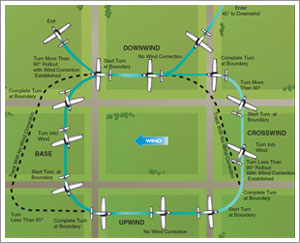
The following stories from the September 7, 2007, edition of AOPA ePilot were provided to AOPA members who expressed an interest in the particular subject areas. Any AOPA member can receive information tailored to their areas of interest by updating their preferences online.
My ePilot - Student Interest, Training Tips
AVOIDING THE OVERSHOOT
The August 31, 2007, Training Tips explained how to use small corrections for staying aligned on the correct glidepath during a final approach to landing. If the wind is blowing in any direction other than straight down the runway, there will also be lateral adjustments to make during your glide. How successfully you stabilize your final approach depends on whether you anticipated the lateral corrections needed.
 Pilot skill at handling this part of the final approach harkens back to the practice of presolo ground-reference maneuvers, which you'll find in Chapter 6 of the Airplane Flying Handbook . That's when you learned how to correct for the effects of wind on your ground track. The rectangular course maneuver previews the wind-drift challenges you will face in the airport traffic pattern. Don't underestimate the value of this maneuver, which introduces you to airport-traffic-pattern-like corrections for drift on the various pattern legs while groundspeed, headwind, or tailwind components are changing. Grasp the concept early and the task won't become a distraction in a real traffic pattern-when you are also managing the descent and landing. Ralph L. Butcher wrote about the maneuver's value in his "Insights" column in the January 2006 AOPA Flight Training . See the article's helpful graphic depicting the effects of wind drift.
Pilot skill at handling this part of the final approach harkens back to the practice of presolo ground-reference maneuvers, which you'll find in Chapter 6 of the Airplane Flying Handbook . That's when you learned how to correct for the effects of wind on your ground track. The rectangular course maneuver previews the wind-drift challenges you will face in the airport traffic pattern. Don't underestimate the value of this maneuver, which introduces you to airport-traffic-pattern-like corrections for drift on the various pattern legs while groundspeed, headwind, or tailwind components are changing. Grasp the concept early and the task won't become a distraction in a real traffic pattern-when you are also managing the descent and landing. Ralph L. Butcher wrote about the maneuver's value in his "Insights" column in the January 2006 AOPA Flight Training . See the article's helpful graphic depicting the effects of wind drift.
Some errors made while correcting for lateral inaccuracy in your traffic-pattern maneuvering simply make for a sloppy approach. But one common error, caused either by flying a too-close-in downwind leg or by failing to anticipate a tailwind component on the base leg, may create a stall/spin hazard responsible for many loss-of-control accidents: When a pilot overshoots the turn from base leg to final, the temptation to bank steeply in a frantic attempt to capture the final approach path can be strong. [See the April 2001 and September 2003 AOPA Flight Training "Instructor Report" columns.] Avoid steep and abrupt maneuvering at low airspeed and low altitude; go around instead. Learn more about stalls and spins and how to avoid them with the AOPA Air Safety Foundation.
Just as with the vertical corrections needed on approach, small and well-timed corrections to capture and maintain your position on the extended runway centerline will keep your approaches orderly. Combining them all to complete a landing is one of aviation's most rewarding and thrilling achievements.
My ePilot - Training Product
SQUAWKBOX MICRO AVIATION SURVIVAL KIT
When you're puttering around the pattern, thoughts of an off-airport landing aren't particularly troubling. But when you progress to cross-country flights, it's time to start thinking about how you would fare if you had to land the airplane in a remote location. Here's where survival kits come in. If you're looking for something that's easily carried in a flight bag, Squawkbox's Micro Aviation Survival Kit comes with 20 items, including a signal mirror, button compass, wire saw, silicone band, emergency "space" blanket, a 25-foot fishing line and hooks, safety pins, water purification tablets, first-aid items, and more. All components fit into a waterproof, airtight case. The kit sells for $38 and is available from Classicjet.
Note: Products listed have not been evaluated by ePilot editors unless otherwise noted. AOPA assumes no responsibility for products or services listed or for claims or actions by manufacturers or vendors.
My ePilot - Student Interest, Final Exam
Question: What is the purpose of a windsock?
Answer: The windsock is a good indicator of wind direction, as well as wind velocity and gusts. The stronger the wind, the straighter the sock extends, with full windsock extension calibrated for a specific wind speed. Windsocks tend to move back and forth when the wind is variable and gusty. They are usually located near the airport runway(s) and may be placed in the center of a segmented circle (which identifies the traffic pattern direction, if it is other than the standard left-hand pattern). Overflying the airfield and observing the windsock before entering the traffic pattern will help you to determine the wind's direction and speed, the runway in use, and the resulting crosswind conditions. Read more about windsocks in the April 2006 AOPA Flight Training .


